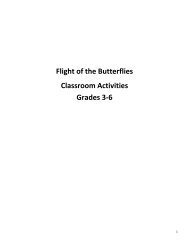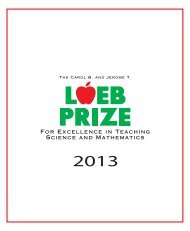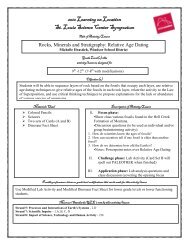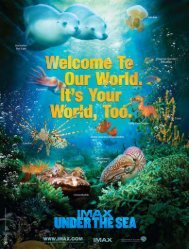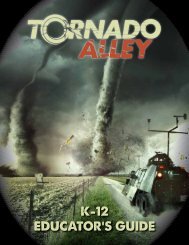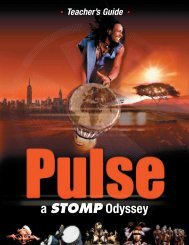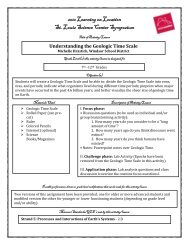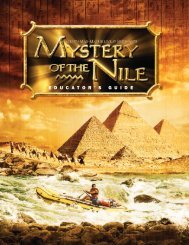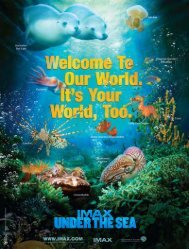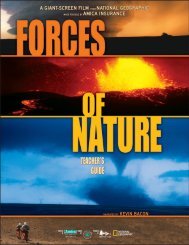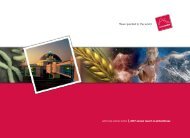Tracking Dinosaurs - St. Louis Science Center
Tracking Dinosaurs - St. Louis Science Center
Tracking Dinosaurs - St. Louis Science Center
You also want an ePaper? Increase the reach of your titles
YUMPU automatically turns print PDFs into web optimized ePapers that Google loves.
2012 Learning on Location<br />
<strong>St</strong>. <strong>Louis</strong> <strong>Science</strong> <strong>Center</strong> Symposium<br />
Title of Activity/Lesson<br />
<strong>Tracking</strong> <strong>Dinosaurs</strong>: <strong>St</strong>udying Trace Fossils<br />
Jeff Conderman, Fort Zumwalt School District<br />
Grade Level(s) thisactivity/lesson is designed for<br />
6 th – 12 th<br />
Objectives / Background Info.<br />
<strong>St</strong>udents will develop an understanding of:<br />
Trace Fossil: A type of fossil that provides evidence of the activities of ancient organisms.<br />
Behavior Trace Fossil: preserved indications of the behavior or activity of an organism. Examples:<br />
(1.) animal tracks and trails, (2.) Burrows, (3.) dwellings, such as bird nests and mammal dens<br />
(4.) feeding indications, such as tooth marks of a predator on its prey’s bones<br />
Somatic Trace Fossil: The term somatic means related to the body. Somatic trace fossils aremolds / impressions and<br />
casts of all or part of the body of an organism but without any actual body hard parts or soft tissues preserved.<br />
1. Internal and external molds and impressions of part or all of a body, such as dinosaur footprint tracks,<br />
impressions of fish scales, molds of clam shells<br />
2. Internal or external casts of part or all of a body, such as casts of a braincase<br />
Materials Used<br />
‣ Lunch trays<br />
‣ Plastic dinosaurs<br />
‣ Play - Dough<br />
‣ Handouts / packets of track examples:<br />
o Hansen, Thor and Slesnick, Irwin. “Adventures in<br />
Paleontology”. Arlington, VA: National <strong>Science</strong><br />
Teachers Association, 2006. Pages 24 – 29.<br />
‣ Paluxy River and Valentia Tetrapod Trackway<br />
photo(s) or similar<br />
‣ Document camera<br />
Description of Activity/Lesson<br />
See activity attachments for<br />
detailed information and<br />
handouts / examples.<br />
Possible performance-driven or grade level modifications that can be made for this activity/lesson<br />
Complexity / expectations of student created trackways can be adjusted based on the grade level / ability of students.<br />
Missouri <strong>St</strong>andards/GLE’s met by this activity/lesson:<br />
<strong>St</strong>ate <strong>St</strong>andard: SC 5, CA I, CA 4 -<br />
<strong>St</strong>ate Goal: 1.1, 1.2, 1.4, 1.5, 1.8, 2.1, 2.3<br />
Grade Level Expectation / GLE: <strong>St</strong>rand 5: 2
Description of Activity/Lesson<br />
Input<br />
1.<br />
2.<br />
Discuss definition(s) of trace fossils<br />
Use Paluxy River and Valentia Tetrapod Trackway photo(s) as examples / discuss:<br />
“The Paluxy River trackway, in Glen Rose, Texas is an excellent example of a real trace fossil. It<br />
shows the trackways of at least five large sauropods (thought to be Brachiosaurs) and three theropod<br />
trackways. The trackway tells us that the sauropod held its legs directly below its body like that of an<br />
elephant, instead of out to the side, like a lizard. There is no evidence of a furrow (tail‐drag) between<br />
the footprints so the very large tail must have been carried off the ground. Because the trackway<br />
does not accurately indicate the time that these events occurred it can only be hypothesized that the<br />
theropods were pursuing the sauropods. It is possible that the tracks could have been made at<br />
different times. FYI: the display at the American Museum of Natural History has only one sauropod<br />
and one theropod trackway… and has an Apatosaurus standing above it.”<br />
“The Valentia Tetrapod Trackway, Valentia Island, Ireland is the oldest in situ record in the world of a<br />
vertebrate walking on land / about 385 million years ago. It shows where a lizard like animal that<br />
was about one meter long dragged itself out of water and walked on wet mud. This trackway<br />
contains both footprints and tail‐drag.<br />
3. Discuss handouts‐‐examples of trace fossils<br />
- Figure 2.8, 2.9, and 2.10:<br />
i. 2 legged (bipedal) tracks are evenly spaced<br />
ii. 4 legged (quadruped) tracks occur in pairs<br />
- Figure 2.13, 2.14, and 2.15:<br />
i. <strong>St</strong>ride length relates to speed / changes in stride length = changes in speed<br />
ii. Changes in direction<br />
- Figure 2.18 and 2.19<br />
i. Did this animal travel in herds or groups? Solitary?<br />
ii. In general the length of a dinosaur footprint is 1/4 ‐ 1/5 the length of its leg. Since<br />
many dinosaurs walked with their backbones parallel to the ground this is also a<br />
rough estimate of their height.<br />
4. In groups students will spread two cans of Play‐Dough onto a lunch tray.<br />
5. Using plastic dinosaurs, students should create tracks in the Play‐Dough. I usually give each group<br />
about six dinosaurs and within that a mix of carnivores / herbivores, biped / quadruped. Consider<br />
also giving students a piece of plastic plant material to help create traces of nests or burrows.<br />
6. Encourage students to use examples and handouts in order to help them create more realistic<br />
scenarios. Ninja kick flips are very cool but not realistic.<br />
7. Once each group has created their scenario share trays among the class. Use a document camera to<br />
display each tray one at a time so everyone can see them.<br />
8. Each time you display a single tray have the students make inferences about what they feel happened<br />
in each scenario. Then have the group that created each tray reveal what they had attempted to<br />
depict.<br />
Closure / Follow Up Activity<br />
This activity is a great opportunity to reinforce the different between observations (what can be<br />
observed using ones senses) and inferences (an educated guess / hypothesis based on ones<br />
observations). Have students write a paragraph explaining the difference between an observation and an<br />
inference using examples from their group’s tray / scenario.
Paluxy River Trackway Photo #1
Paluxy River Trackway Photo #2
Valencia Tetrapod Photo #1
Valencia Tetrapod Photo #2
Valencia Tetrapod Photo #3
Valencia Tetrapod Photo #4
Trackway Activity Example Photos


